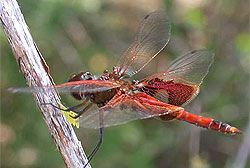 |
 | |
  | |
|
|
|
|
Amistad National Recreation Area
Nature & Science
|
|
|
|
|
|
 |
 |
| Dragonflies thrive in healthy aquatic habitats |
 |
Amistad National Recreation Area supports flora and fauna in a combination not found in any other National Park Service site. This biodiversity is a result of the park’s location in a transition zone between three major plant communities: Tamaulipan Shrubland, Chihuahuan Desert, and Edwards Plateau. This mix of habitats is combined with a huge expanse of the clear, clean waters of Amistad Reservoir.
People use Amistad Reservoir year round. In contrast, some animals utilize the area only during seasonal migrations. In the fall, thousands of Monarch butterflies roost on park lands before continuing their journey south to wintering sites in Mexico. Many waterfowl species spend the winter on the lake before returning north in the spring. Even endangered and threatened species, such as the Interior least tern, use the lake to nest and raise young.
The National Park Service and state agencies have implemented several projects in order to monitor the natural resources of the lake and surrounding areas. Extensive inventories of flora and fauna, yearly Monarch butterfly tagging, and monthly water quality testing provide invaluable data. By monitoring changes, park staff can quickly take measures to conserve the natural resources and beauty of Amistad National Recreation Area.
|
|  |  |

|
 |
|
|
|
|
|
 |
|
Did You Know?
With an estimated 1,400,000 prehistoric artifacts in the park’s museum collection, Amistad National Recreation Area has the third largest collection in the National Park Service.
|
|
|
|
Last Updated: July 15, 2007 at 10:14 EST |






